Using Art To Ease Stress and Anxiety in Young People
Modern life presents unprecedented stresses and challenges for young people. The constant connection of technology and social media doesn’t allow for the same “rest and digest” time of previous generations.
Uncertainty around the future and distressing world events impact on the wellbeing of the young person. They’ve witnessed wars, pandemics, economic inequality and climate crises. Having constant access to the internet means they are exposed to all sorts of stressors and upsetting stories that can have a profound influence on their world view and how hopeful they feel about their own future prospects.
Urie Bronfenbrenner explored the concept of how various systems impact children and young people. In his Ecological Systems Theory (Bronfenbrenner, 1979) his model puts the individual at the centre and shows how different environmental layers influence their life; from parenting to school to media to the wider modern context.
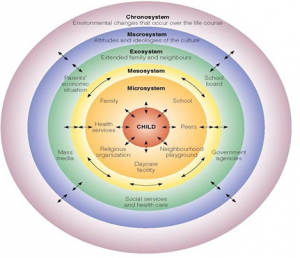
The learning ecology model of Brofenbrenner (1979). From Rhodes (2013).
Human beings were not designed to be constantly aware of so much at once. It’s enough to contend with our own lives and dramas without being always connected to the wider world. We need time for our nervous systems to settle and recharge.
Creativity is an excellent outlet for young people to manage their worries and their anxiety. Making marks on a page or having autonomy over something they are worried about can give them a sense of empowerment.
Combat Negative Thinking
A lot of young people struggle with patterns of negative thinking. These can be in the form of always thinking the worst case scenario, of blaming themselves, blaming others, expecting perfection, only seeing the negatives or thinking in terms of all or nothing.
These thinking patterns can negatively impact mood and behaviour so it’s important for young people to begin to notice and become aware of these patterns.
A creative way of doing that is to represent these thoughts as a cartoon or character with exaggerated features and personality.
This means that they can disentangle themselves from the thoughts and bring in some humour. Using this approach is called Cognitive Defusion and is a powerful technique in ACT (Acceptance Commitment Therapy) (Harris, 2008) (Hayes, 1999)
The young person can also represent their Inner Critic and then their Inner Champion. This will help them to realise that they can take control of their self talk and change it to be self compassionate. Having positive self-talk builds resilience and a growth mindset. This art exercise brings awareness to their inner voice and whether it is helpful or harmful.
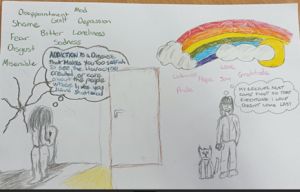
Inner critic and inner champion exercise
Collaging For Anxiety Relief
Some young people might initially struggle with the idea of creativity. They might feel the inner critic is too strong and they won’t do it properly or good enough.
A trauma informed way of counteracting these blocks is to use collaging. Pre-cut images and words from magazines are a gentle, easy way to explore their creative expression with no pressure to get it right. Stickers with positive statements and affirmations can bring in further benefits of positive psychology and motivation.



Collages created by group attendees
Brain Dump
When the brain feels overloaded, like a computer with too many tabs open; it is helpful to dump those thoughts onto a page.
This can be done as abstract words and doodles or as a more structured mind map.
When the young person sees it on the page, they begin to realise that what felt like an overwhelming burden is actually manageable. They can look at problem solving strategies for those things that are in their control and think of coping strategies for the things that aren’t in their control.
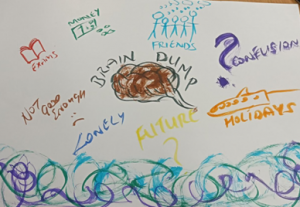
Brain dump created by a young person
It’s In Their Hands
A powerful art exercise for young people is to trace around their hands on a page (Malchiodi, 2012) The left hand can represent the past and the right hand represents the future. Another way of using this is that the left hand is what they want to let go of and the right hand is what they want to reel in to their lives.
This gives a visual representation of where they are at and what they want. This can inspire them for the actions they need to achieve this imagined future.
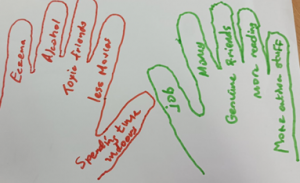
Emotions Pizza
Drawing a circle template, the young person divides this into slices of emotions that they currently feel (Plutchik, 1980)
They can fill those slices with colours, words or doodles that show what they are feeling.
This helps them with emotional regulation and being able to “name it to tame it” (Siegel, 2011)
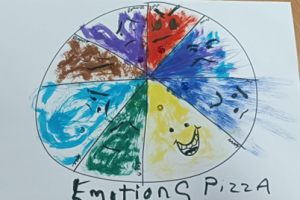
Positivity Journaling
For the inevitable tough days, it is important to have a toolbox of coping strategies that work. One fun way to do this is to create a positivity journal. The young person can fill this with phrases, pictures, activities, dreams and hopes that give them a boost of happy feelings.
This journal can give them perspective when they are feeling down and helps them to self regulate and self soothe (Petersen et al, 2012)
Small toys or items can be added in an envelope or box that will help the young person to calm themselves. They can spray pages with their favourite scent and make a playlist of positivity to go with it. This gets them using their senses to self regulate.
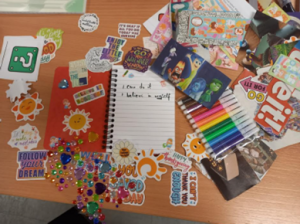
The added benefit of the above exercises are that they are accessible and don’t require skill or talent, just some creativity and art supplies!
Author:
Deirdre McCormick
Integrative Counsellor/ Art Therapist
MIACP
linkedin.com/in/deearttherapy/
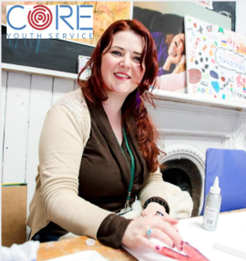
References
Brnfenbrenner, U. (1979). The Ecology of Human Development: Experiments by nature and
design. Cambridge, MA: Harvard University Press, 1–348
Harris, R., 2008. The happiness trap: Stop struggling, start living. Boston: Trumpeter.
Hayes, S.C., Strosahl, K.D. and Wilson, K.G., 1999. Acceptance and commitment therapy: An experiential approach to behavior change. New York: Guilford Press.
Malchiodi, C. A. (2012). Handbook of Art Therapy (2nd ed.). New York: The Guilford Press.
Peterson JC, Charlson ME, Hoffman Z, Wells MT, Wong S, Hollenberg JP, Jobe JB, Boschert KA, Isen AM, Allegrante JP (2012) A randomized controlled trial of positive-affect induction to promote physical activity after percutaneous coronary intervention. Arch Intern Med. Feb 27;172(4):329–36. doi: 10.1001/archinternmed.2011.1311.
Plutchik, R., 1980. Emotion: A psychoevolutionary synthesis. New York: Harper & Row.
Rhodes, S. (2013). Theories of Child development [Powerpoint]. Retrieved from
Siegel, D. J., & Bryson, T. P. (2011).
The Whole-Brain Child: 12 Revolutionary Strategies to Nurture Your Child’s Developing Mind. New York: Delacorte Press.
Smyth JM, Johnson JA, Auer BJ, Lehman E, Talamo G, Sciamanna CN. (2018) Online Positive Affect Journaling in the Improvement of Mental Distress and Well-Being in General Medical Patients With Elevated Anxiety Symptoms: A Preliminary Randomized Controlled Trial. JMIR Ment Health. Dec 10;5(4):e11290.

